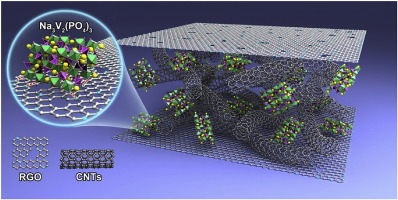周小四教授课题组在JOURNAL OF ALLOYS AND COMPOUNDS发表研究论文
An efficient sodium-ion battery consisting of reduced graphene oxide bonded Na3V2(PO4)(3) in a composite carbon network
Gu, EL (Gu, Erlong)[ 1 ] ; Liu, SH (Liu, Shuhu)[ 2 ] ; Zhang, ZZ (Zhang, Zhuangzhuang)[ 1 ] ; Fang, YY (Fang, Yuyan)[ 1 ] ; Zhou, XS (Zhou, Xiaosi)[ 1 ]*(周小四) ; Bao, JC (Bao, Jianchun)[ 1 ]
[ 1 ] Nanjing Normal Univ, Jiangsu Key Lab New Power Batteries, Sch Chem & Mat Sci, Jiangsu Collaborat Innovat Ctr Biomed Funct Mat, Nanjing 210023, Jiangsu, Peoples R China
[ 2 ] Chinese Acad Sci, Inst High Energy Phys IHEP, Beijing Synchrotron Radiat Facil BSRF, Beijing 100049, Peoples R China
JOURNAL OF ALLOYS AND COMPOUNDS,201810,767,131-140
Sodium-ion batteries have been considered as the most promising candidate for large-scale energy storage applications. However, the poor cycling stability and inferior rate capability of existing cathode materials for sodium-ion batteries restrict future developments. Herein, we report a chemically bonded cathode material for sodium-ion batteries that is synthesized by freeze-drying and subsequent annealing to generate Na3V2(PO4)(3)/reduced graphene oxide-carbon nanotubes (NGC) composite. The NGC composite with 79 wt % Na3V2(PO4)(3) shows a high initial Coulombic efficiency (>93%) and high specific capacity with superior cycling stability (similar to 105 mAh g(-1) after 500 cycles at 1 C based on the mass of Na3V2(PO4)(3)). More importantly, in situ electrochemical impedance spectroscopy and ex situ X-ray diffraction, X-ray photoelectron spectroscopy, X-ray absorption near edge structure spectroscopy, and transmission electronic microscopy are employed to reveal the robust V-O-N bonding and excellent sodium storage performance of the NGC composite.

文章链接:
https://www.sciencedirect.com/science/article/pii/S0925838818325830?via%3Dihub
版权与免责声明:本网页的内容由收集互联网上公开发布的信息整理获得。目的在于传递信息及分享,并不意味着赞同其观点或证实其真实性,也不构成其他建议。仅提供交流平台,不为其版权负责。如涉及侵权,请联系我们及时修改或删除。邮箱:sales@allpeptide.com